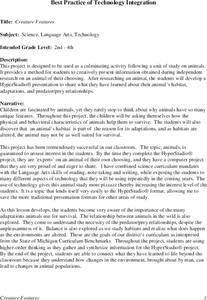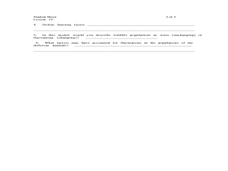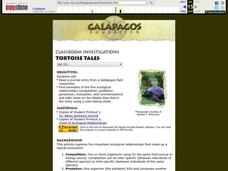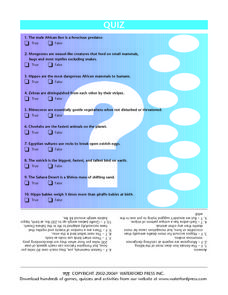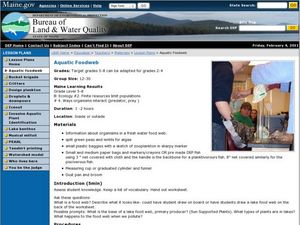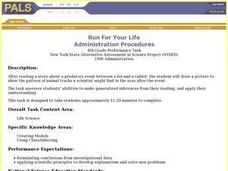Curated OER
Fungi
The general characteristics that affect the classification of fungi and other organisms in the domain Eukarya are detailed on 12 attractive slides. Teachers can access individual slides to cover life cycles or diversity, or can use the...
Curated OER
EcoFluxx
Students describe examples of predator/prey relationships in nature explain how some animals protect themselves from predation better follow all directions presented to them become more flexible, adaptable and literate learners. They...
Curated OER
CSI Clamshell Investigation
Students explore predator/prey relationships. They research information on moon snails and claims. Students draw conclusions from the data collected. They use math and graphing to determine if there is a relationship to the clam's size...
Curated OER
The Big Bad Wolf
Tenth graders analyze the popular fairy tale "The Three Little Pigs" for inaccurate references to wolves. They write a story (or compose a song) that correctly depicts the characteristics, traits and predator-prey relationship of a wolf.
Curated OER
Paleoecology Using "Fossilized" Owl Pellets
Young scholars study the differences in anatomy to help identify different species and use a dichotomous key to identify what the owls were eating. In this investigative lesson students dissect owl pellets to identify the species...
Curated OER
Creature Features
Students investigate animals and how they adapt to their environment. They design a multimedia presentation that includes information about an animal of their choice. They include a title card, habitats, adaptations, and a predator/ prey...
Curated OER
Oh Panther
Students play a game that replicates the balance of prey and predators in an ecosystem. For this physical education lesson, students follow the instructions to play "Oh Panther!" Students collect data regarding the game and discuss the...
Curated OER
Owls - Reading Comprehension
In this science reading comprehension learning exercise, students read a selection that describes the characteristics and habits of owls. They answer 7 multiple choice questions based on the reading.
Curated OER
The Acetate Animal Hunt
Students determine which adaptations allow an organism to survive and reproduce in a certain environment. Students act as "predators" to pick up acetate discs "prey" scattered around the classroom. Students list the number found, the...
Curated OER
Tortoise Tales
Pupils read journal entry from a Gal??pagos field researcher, find examples of five ecological relationships (competition, predation, parasitism, mutualism, and commensalism) and take notes on the details they find in the entry using a...
Curated OER
Spiders are Special
First graders recognize that spiders are important natural predators. They work in small groups with simple field guides to identify as many of their spiders as they can.
Curated OER
Owl Word Unscramble
For this science related worksheet, students practice the skill of unscrambling ten words associated with owls and their habitats.
Curated OER
Quiz: African Animals
In this science worksheet, 3rd graders will respond to questions pertaining to African animals. Students will answer ten questions consisting of true/false, and multiple choice.
Curated OER
Aquatic Foodweb
Learners explore what a food web is. In this science lesson, students examine how nutrients and other pollutants enter a lake and play a food web game whereby learners pretend they are either zooplankton, planktivore,...
Curated OER
Ecology Terms Crossword
In this ecological principles worksheet, students solve 20 clues in a crossword puzzle containing basic ecology definitions of organism interactions.
Curated OER
Mariposas
Students examine how animals use camouflage for survival. In this investigative lesson students define vocabulary words and see how it is the environment that controls which adaptations will help in survival.
Curated OER
Run For Your Life
Young scholars draw a picture of animal tracks a scientist might find after they read a story about a fox chasing a rabbit. They make up a key to represent the foxes' tracks and the rabbit's tracks.
Curated OER
Producers, Consumers, and the Food Chain
Third graders discuss producers, consumers, and the food chain. In this producers and consumers instructional activity, 3rd graders talk about organisms, the food chain, and the difference between producers and consumers. They complete...
Curated OER
Amusing Animal Adaptations
Students identify how animals adapt characteristics to help them survive or reproduce. In this animal lesson, students draw pictures of their animal and adaptation.
Curated OER
Natural Selection
Kids act as scientists and preditors in this short natural selection activity; they collect and analyze data, then apply their new knowledge to real-world examples of natural selection. The layout of the worksheet is easy enough to use...
Curated OER
Endangered Species in the Sonoran Desert
Learners identify and explain some caused of endangerment and extinction for species as well as explain the effects of extinction on an ecosystem. Teachers use this lesson plan before teaching students about collecting insects or plants.
University of Kentucky
The Great Spider Debate
Poor, misunderstood spiders! They are feared, disrespected, and detested by many people, yet they do so many positive things. A great addition to any insect unit, learn about some of the more common spiders, while hopefully dispelling...
Curated OER
Wild Where?
Students investigate why the urban environment is considered a hostile environment; define the concept of endangered species; describe and identify a Peregrine Falcon; describe and identify the eating habits of the Peregrine Falcon.
American Museum of Natural History
What's This? Feeding
Some species have pretty creative methods for catching food. Young scientists learn about some interesting ways organisms get the nutrients they need by navigating an online interactive lesson that would be suitable for a remote learning...





